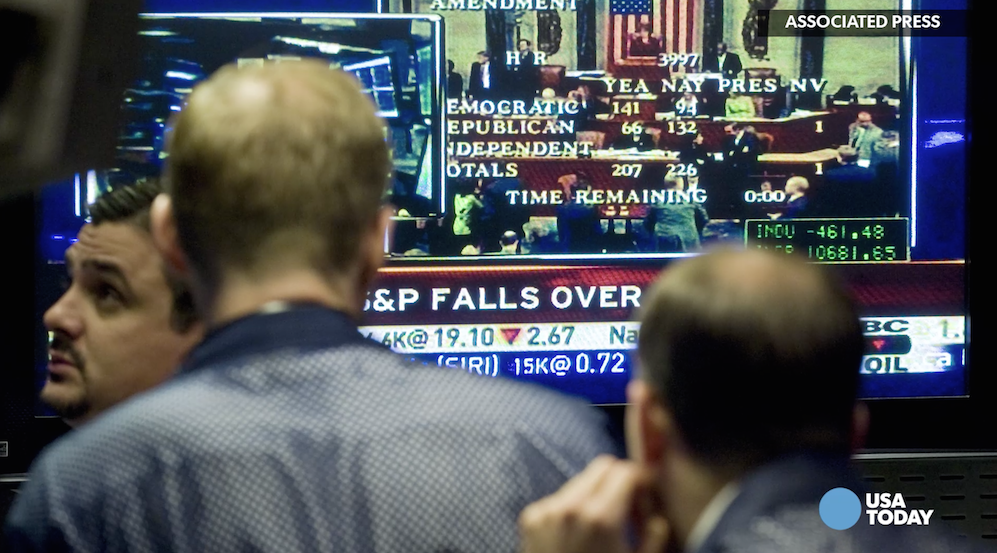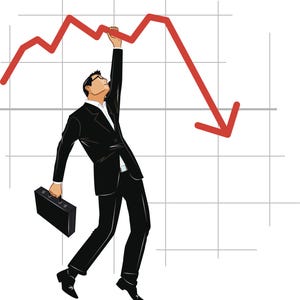The big selloff on Wall Street to start 2016 is now the worst four-day start to the year ever for the broad U.S. stock market following repeated waves of selling Thursday that sent the Dow tumbling almost 400 points and thrust the Nasdaq back into correction territory amid a global stock rout that started when China halted trading in its market again following a 7% plunge.
The Standard & Poor’s 500 stock index lost 2.4% to 1943.09. The S&P is down 4.93% this year, eclipsing its prior worst four-day start of -4.48% back in 2000, according to S&P Dow Jones indices.The Dow Jones industrial average lost 392 points, or 2.3%, to 16,514.10. Its 5.23% drop so far this year is also its worst start ever.
The real drama was in the tech-heavy Nasdaq composite, which plunged 3% to 4689.43, leaving it more than 10% below its July record close and officially back in correction territory.
The sledding continues to be treacherous on Wall Street, which started the session already off to its worst three-day start to a new year since the financial crisis in 2008. And China was again the epicenter of Thursday’s sell-off. Sparking angst was a freefall in Chinese stocks at the start of trading Thursday, which triggered a shutdown of theChinese stock market about 30 minutes into the trading session — marking the shortest trading day in the market’s short history. It was the second trading halt this week.
After the rout in the Chinese stock market Thursday, Chinese authorities suspended the new trading “circuit breakers” that are intended to damp panic but which many market-watchers argue sowed more panic, according to China’s official news agency Xinhua. The circuit breaker system was implemented at the start of this year.
Stocks are selling off around the world because of major volatility in China’s stock market early in 2016. Fears of a bigger-than-expected slowdown in the world’s second-biggest economy are on the rise, which is a negative for markets as China has been one of the world’s biggest drivers of growth in recent years. Fears range from China exporting recession to the world to China fomenting another crisis in global markets. There is also great concern that Chinese authorities are making the situation worse — and that China’s willingness to let its currency, the yuan, weaken is signaling an even weaker economic situation in China.
U.S.-based strategists say the massive volatility to start the new year is not the start of another 2008-style financial crisis, but rather a big correction very much similar to the big China-inspired drop this past August. The summer swoon sparked by a similar stock meltdown in China and fears about Chinese growth, of course, pushed the U.S. stock market into its first 10%-plus drop, or correction, in four years. The S&P 500 fell 12.4% from its high to low this summer.
“This is very much August all over again,” says David Kelly, chief global strategist at JP Morgan Funds. “The problem is no one knows where the bottom is for Chinese stocks or for (its currency) the yuan.”
Kelly says while “we can’t time the exact extent or timing of the market slide,” he also expected Chinese authorities to step in once again to try to calm markets — which they did late Thursday when they suspended the trading circuit breakers. Stocks, he predicts, will bounce with more signs of more China support.
“China will very likely act to stabilize markets and at some stage I expect a significant rally as investors move in to buy the dip,” Kelly told USA TODAY in an e-mail. “The two key things for U.S. investors to recognize is that both the U.S. and global economies are growing steadily, if slowly, and that equities generally look cheap relative to cash and high-quality bonds.”
Many market watchers say the steps Chinese authorities are taking to stem the panic — adding circuit breakers to cool things off when markets fall a lot very fast and restricting selling of shares by big investors, to name a few — is actually adding to the panic and making volatility worse.
Says Guo Yanhong, analyst from Beijing- based Founder Securities: “The circuit breaker has caused great panic, leading a sharp contraction of liquidity. The fact that it has been triggered twice in four days four days, only illustrates that it is a big mistake and should be abandoned.”
The Shanghai composite index, a Chinese stock gauge filled with local Chinese shares that are owned mainly by local indvidual investors in China, fell another 7% today, extending its losses in the first four days of the year to 11.7%.
The CSI 300 of companies listed in Shanghai and Shenzhen fell 7.2% in the first 30 minutes of trading Thursday, tripping a circuit-breaking mechanism that went into effect this week.
The selloff in China quickly spread around the world, although the losses have been trimmed in Europe, as well.
In Europe, Germany’s DAX index was down 2.3%, after an earlier plunge of 3.5%, France’s CAC 40 was down 1.7% after an earlier drop of 2.8% and Britain’s FTSE 100was off 2.0%.
Japan’s Nikkei index tumbled 2.3% to close at 17,767.34. Hong Kong’s Hang Seng index dropped 3.1% to finish at 20,333.34.
Adding to the market’s woes was another drop in oil prices as U.S. benchmark crude fell more than 3% earlier Thursday to below $33 a barrel. But U.S.-based crude has also bounced back and is down closer to 1%. Brent crude had fallen 2.5% to $33.39 a barrel.
The trading halt was the second this week for China’s stock market as worries continued over its economy — and North Korea’s reported hydrogen bomb test.
Chinese stock exchanges closed early Thursday after the CSI 300 Index dropped more than 7%. The slide came after China’s central bank lowered the yuan’s daily reference rate by the most since last summer.
#MARKETS16: Stock picks | Shocks to watch | Questions | Bull or bear? | Rocky start
This was a troubling development after U.S. markets posted another turbulent session Wednesday as investors got blindsided by yet another early-year shock: claims from North Kore that it successfully tested a powerful hydrogen bomb.
2016 has been awful so far, with the Dow Jones industrial average logging its worst three-day stretch in a new year since the financial-crisis days of 2008.
The news out of North Korea rattled investors around the globe. The latest geopolitical flare-up in an increasingly volatile world prompted investors to sell stocks and reduce risk.
But more troubling about China’s plunge is that the nuclear saber-rattling came just days after the first shock of the year: a major plunge in shares of mainland China stocks and renewed global growth fears sparked by weak manufacturing readings in China and the U.S. A weaker-than-expected reading today on China’s services economy — which hit a 17-month low — added to worries about the global economy.
“We are just three days into the year and already global event risk is dominating the financial market landscape everywhere,” David Rosenberg, chief economist and stratetist at Gluskin Sheff said in a research note.
Chinese shares plummeted 7% in just 30 minutes of trading, triggering circuit breakers and causing the shortest trading day in Chinese stock market history. It’s the second time this week, the Chinese market has been halted due to a freefall. Newslook

Stocks are off to a rocky start in 2016 and people are fearing the worst – a repeat of the 2008 financial crisis. Is it too soon to worry? David Craig with America’s Markets.
Contributing: Adam Shell, Jane Onyanga-Omara and Kirk Spitzer




